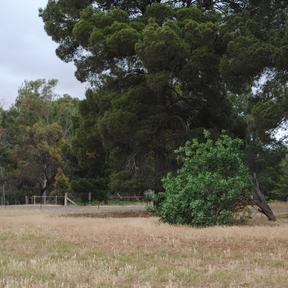Level of Significance
- File
- Local
- Regional
- State
- National
Age
165yrsTrees
1Diameter
0.3mHeight - 4m


Details
- Horicultural/Genetic (Scientific)
- Seed/Propagation Stock (Scientific)
- Resistance (Scientific)
- Park/Garden/Town (Historic)
- Person/Group/Institution (Historic)
Statement of Significance
This last surviving specimen of Pistacia vera is a very early introduction of this species of tree in Australian agricultural and botanical history. It is linked to the Founder of Anlaby and his second Station Manager/Australian Representative. The c.1860 planting of the original fruit orchard along with the experimental planting of edible and/or agriculturally valuable trees and plants is a significant historical context for this specimen’s origin on the property.
This specimen of Pistacia vera is significant from historical, cultural, botanical, agricultural and horticultural perspectives. From these perspectives and its contribution to the landscape of a notable South Australian pastoral property and garden makes it significant for the State of South Australia.
Location
On the side of an internal service road at ‘Anlaby’
Other
This nominated specimen may be the earliest known Pistacia vera in South Australia (and possibly Australia). Dr Roger Spencer notes in his work: Horticultural Flora of South-Eastern Australia. The Identification of Garden and Cultivated Plants. Flowering Plants. Dicotyledons. Part 2, Volume 3, (page 529), that the first Pistacia vera were planted in 1935. Interest in the tree increased during the 1960’s with the CSIRO research into the species at Merbein, Victoria. Commercial production and interest took off during the 1980’s in drier inland areas like Kyalite, New South Wales; Robinvale and Kaniva in Victoria and Loxton and Pinnaroo in South Australia. It is hard to ascertain and prove whether Frederick Dutton and Alexander Buchanan realised any commercial potential in the species for its edible nut. The nominated specimen was planted at Anlaby over 70 years before the first specimens were planted in Australia. Only two (2) species of Pistacia were grown at ‘Camden Park’ in New South Wales – the home of Sir William MacArthur, between c.1820 – 1861 (Hortus Camdenensis). Both Pistacia terebinthus (Terpentine Tree) and Pistacia lentiscus (Mastic Tree) were grown. They were grown for their resin or mastic. Pistacia vera was introduced to California in the United States in 1854.



